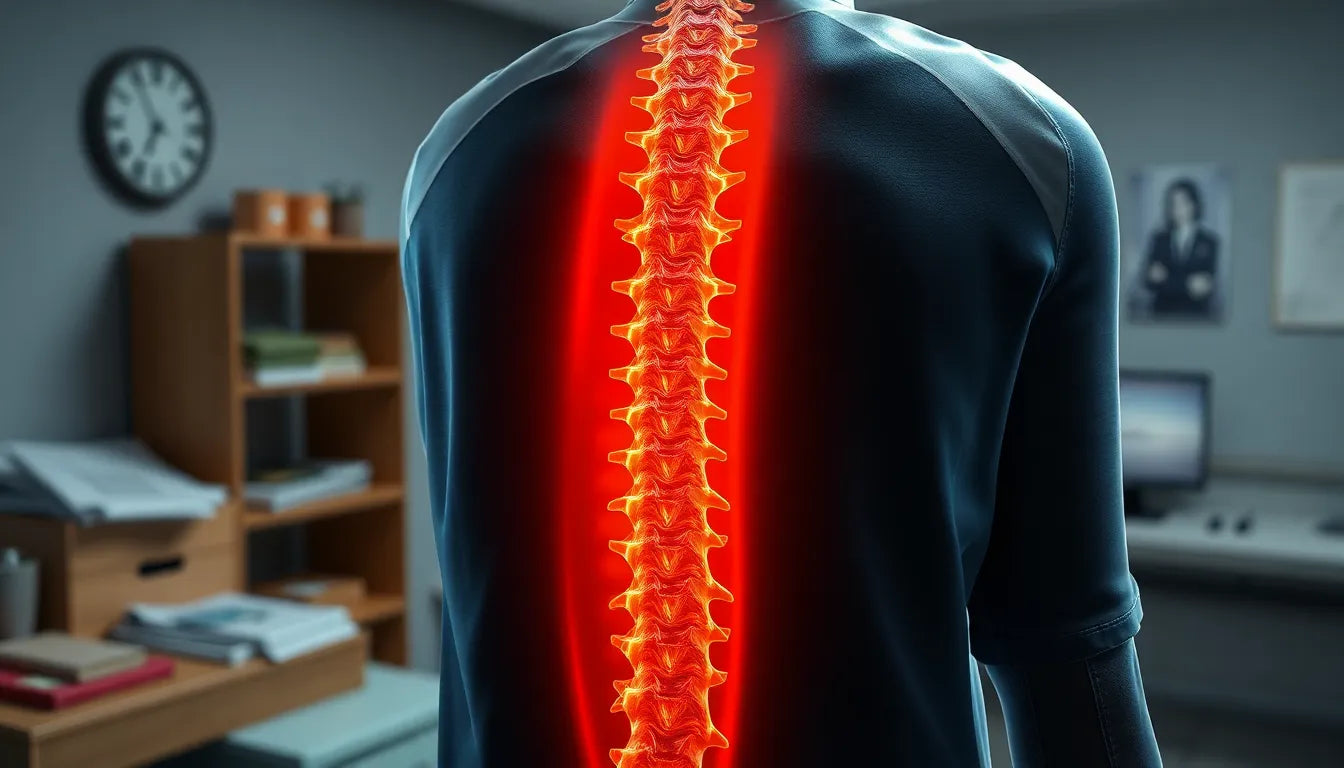Is your back pain more than just a minor ache? Understanding the signs of a herniated disc can be crucial for effective treatment and long-term relief. A herniated disc, often referred to as a slipped or ruptured disc, occurs when the soft inner gel of an intervertebral disc pushes through a crack in the tougher exterior casing. This condition can lead to significant discomfort and, if left untreated, may cause further complications.
Recognizing the early symptoms of a herniated disc is essential for effective management and treatment. Many people experience back pain at some point in their lives, but identifying when this pain is indicative of a herniated disc is key to preventing further damage. The symptoms can vary widely, often depending on the location of the herniation and the individual’s unique anatomy. Common signs include pain that radiates into the legs or arms, numbness, tingling, and muscle weakness.
The purpose of this blog post is to provide comprehensive information on identifying a herniated disc, including symptoms, diagnosis, and potential treatment options. By understanding the signs and seeking appropriate medical advice, you can take proactive steps towards recovery and improved quality of life. In the sections that follow, we will delve deeper into the anatomy of the spine, explore common causes of herniated discs, and discuss the diagnostic processes used by healthcare professionals.
Whether you're experiencing persistent back pain or have noticed other unusual symptoms, this guide aims to equip you with the knowledge needed to make informed decisions about your health. With early detection and the right approach, managing a herniated disc can become a more straightforward process, helping you regain comfort and mobility.
Understanding herniated discs
Understanding herniated discs
To grasp how a herniated disc occurs, it's essential to first understand the anatomy of the spine. The spine is composed of vertebrae, which are stacked on top of one another, creating a protective column for the spinal cord. Between each vertebra lies an intervertebral disc, acting as a cushion to absorb shock and provide flexibility to the spine. These discs have a tough outer layer and a softer, gel-like center. When the outer layer weakens or tears, the inner gel can protrude, leading to what is known as a herniated disc.
Causes of herniated discs
Several factors can contribute to the development of a herniated disc. Age-related wear and tear, known as disc degeneration, is a common cause. As you age, your discs lose water content, making them less flexible and more prone to tearing. Improper lifting techniques, such as bending at the waist instead of the knees, can also exert excessive pressure on the spine, leading to herniation. Additionally, sudden trauma from a fall or accident can cause a disc to rupture. It's crucial to be mindful of these causes to prevent unnecessary strain on your spine.
Recognizing the symptoms of a herniated disc
The symptoms of a herniated disc can vary significantly depending on the location and severity of the herniation. One of the most common symptoms is pain that radiates into the legs, commonly referred to as sciatica. This occurs when the herniated disc compresses a nearby nerve, causing pain to travel along the nerve's path. You might also experience numbness or tingling in the limbs, as well as muscle weakness and loss of reflexes. Lower back pain and muscle spasms are additional symptoms that can indicate a herniated disc.
Symptom checklist
- Pain radiating into one or both legs
- Numbness or tingling in the arms or legs
- Muscle weakness
- Loss of reflexes in the legs
- Lower back pain
- Muscle spasms
Diagnosing a herniated disc
Diagnosing a herniated disc typically begins with a thorough medical history and physical examination. Your doctor will ask about your symptoms, their duration, and any activities that worsen or alleviate your pain. During the physical exam, they may check your reflexes, muscle strength, and the range of motion in your spine. If a herniated disc is suspected, imaging tests such as an MRI or X-ray may be ordered to confirm the diagnosis. These tests provide detailed images of the spine, allowing doctors to identify the exact location and severity of the herniation.
| Imaging Test | Purpose |
|---|---|
| MRI | Provides detailed images of soft tissues, including discs and nerves |
| X-ray | Helps rule out other causes of back pain, such as fractures |
| CT Scan | Offers a more detailed view than X-rays, often used if MRI is not an option |
Understanding the signs and symptoms of a herniated disc, along with the diagnostic process, is crucial for obtaining the right treatment. Early detection can lead to more effective management and a quicker recovery, allowing you to return to your daily activities with less pain and discomfort.
Treatment options for herniated discs
When it comes to managing a herniated disc, treatment options can vary depending on the severity of the condition and the individual's overall health. Non-surgical treatments are often the first line of defense and can be highly effective for many people.
Non-surgical treatments
Physical therapy is a cornerstone of non-surgical treatment, focusing on exercises that strengthen the muscles supporting the spine, improve flexibility, and reduce pain. Medications such as nonsteroidal anti-inflammatory drugs (NSAIDs) can help manage pain and inflammation. Lifestyle changes, including maintaining a healthy weight and quitting smoking, are also crucial as they can reduce stress on the spine and promote healing.
Ergonomic solutions, such as using chairs with proper lumbar support or adjusting your workstation, can prevent further strain on your back. These adjustments are simple yet effective ways to manage symptoms and improve quality of life.
Surgical options
While most cases of herniated discs can be managed with conservative treatments, surgery may be necessary if symptoms do not improve or if there is significant nerve compression. Surgical procedures, such as a discectomy or laminectomy, aim to relieve pressure on the affected nerve by removing the herniated portion of the disc or part of the bone. It's important to discuss the risks and benefits of surgery with your healthcare provider to determine the best course of action.
Preventive measures
Prevention plays a key role in reducing the risk of developing a herniated disc. Incorporating regular exercise into your routine strengthens the muscles that support your spine, improving overall stability and flexibility. Practicing good posture, both when standing and sitting, helps maintain the natural curve of your spine and reduces stress on your discs.
Maintaining a healthy weight is also essential, as excess body weight can increase pressure on the spine. Ergonomic aids, such as adjustable desks and supportive chairs, can enhance your workspace and help prevent unnecessary strain on your back.
Personal stories and case studies
Real-life experiences can provide valuable insights into managing a herniated disc. For instance, many individuals have found success through a combination of physical therapy and lifestyle adjustments. One patient, John, a 45-year-old office worker, managed his herniated disc by incorporating daily stretching routines and using an ergonomic chair at work. His commitment to these changes significantly reduced his pain and improved his mobility.
Frequently asked questions
What is a herniated disc?
A herniated disc occurs when the soft inner gel of an intervertebral disc pushes through a tear in the tougher outer layer. This can lead to nerve compression, causing pain and other symptoms.
How can I tell if I have a herniated disc?
Key symptoms of a herniated disc include pain radiating into the legs or arms, numbness, tingling, muscle weakness, and lower back pain. If you experience these symptoms, it is advisable to seek medical evaluation.
When should I see a doctor for back pain?
Consult a doctor if your back pain persists for more than a few weeks, is severe, or is accompanied by symptoms like numbness, weakness, or loss of bladder control. Early evaluation can prevent further complications.
Can a herniated disc heal on its own?
In some cases, a herniated disc can heal naturally over time with rest and conservative treatments. However, if symptoms persist or worsen, medical intervention may be necessary.
What are the best exercises for a herniated disc?
Exercises that focus on core strengthening, flexibility, and low-impact aerobic activities are beneficial. Always consult with a physical therapist to ensure exercises are safe and appropriate for your condition.
How can ergonomic aids help with a herniated disc?
Ergonomic aids, such as supportive chairs and adjustable desks, can help maintain proper posture and reduce strain on the spine. These tools are instrumental in managing symptoms and preventing further issues.























